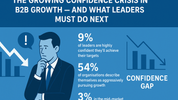I’ve spoken to more than a hundred and fifty technology and services companies (in 18 months) and not one of them can pin point their differentiating commercial value, not even against their top two competitors. Nor have they understood why a client should buy their solution now and if they don’t, what the affects to their business are.
The world of MarTech is complex, it arguably includes SalesTech and AdTech which together consists of 10,000+ companies, a great chunk of which compete in one form or another.
Confusion is normal place when most that compete sound the same and the ones who want to sound different try to create a new category, a new acronym to remember and lose sight of what’s really important to potential customers and that’s the impact you deliver.
It’s difficult to change mindset.
Which is why most sales reps default to the base position, the product where they still feel the war is won on the feature and function battle field and whilst they know they will be killed if they walk onto it, they still do. Why? Because they don’t know how to take the winning fight to the right battle, and execute. Or slightly better, they position use cases, but so does everyone else nowadays. That in itself is not demonstrating differentiating value.
Sales reps continue to share intel from the front line, “the customer wants the system to do ‘x’, and if it can’t do ‘y’ then it’s a deal breaker for them.”
Occasionally, the operational limitations of your customer are such that the value for them is ease-of-use, to perform a set of specific tasks and that’s when you know you’re in the wrong fight or there’s a lot of work to do if you want to highlight a different problem and convince your buyer it’s a bigger priority than the one they’re trying to fix now. How many of your reps choose that fight, and win?
It usually boils down to the fact you’re too late and the battle is already won, by your competition or the status quo.
If this is the case your team is not building enough relationships at scale across their territory and do not know how to rewind and redefine the purchase criteria if they come up against this challenge. Not an easy activity to do, even for the well-trained.
The good news is, like many teams before I can help you and your teams to:
1). Learn how to get in earlier via a scalable relationship first approach, aka Digital Selling and Social Influence.
2). Learn how to rewind the purchase process and align the purchase criteria to the commercial strengths of your solution.
*Warning: point 2 requires the following to be defined:
- Value story
- Path to value
- Value levers
- ROI model that quantifies YOUR differentiating commercial value
- Guided sales and coaching path based on a set of behaviours - to scale performance
These points will need to be defined if you want to articulate and quantify the commercial value your solution delivers to your customers.
Most people think it needs to be a complex set of calculations that focus on the end result when in fact the steps you take them through of getting to the calculation that's more important, it is the ease in which you help your buyer navigate their buying process (which isn't linear) and the ‘experience’ you provide to your buyer along the way that wins - NOT YOUR PRODUCT (whether you've productised Tech or Services).
Exploring value levers together with your buyer shows you know what controls the level of impact they can achieve by working with you and feel more affinity with your solution, things like:
- The rate of progress
- Depth of sophistication
- Alignment of people and resources
- Overcoming potential roadblocks and it’s affect on the value of the project
- How sophistication affects cost and revenue
- How this compares to alternative solutions on the market
It is these topics and your ability to help your buyer navigate the discussion that allows you to reach a point where you can confidently articulate and quantify the commercial value of your solution.
As a sales leader or business owner that’s the starting point.
Next you will need to consider an enablement program, one that focuses more on the application of knowledge as opposed to the acquisition of it.
The knowledge itself is one thing, the real value is learning how to apply it effectively.
First with your leadership and supporting team and then with your revenue facing teams.
And depending on the size of your organisation and the budget you have, this will dictate the scale you can reach and timeline to achieve it.
Start off small, enable a core group first. Focus on a smaller set of targets to prove the approach. And be respectful of the time it will take to enable.
I can think of three deals that otherwise would not have happened if it wasn’t for knowing how to apply the knowledge:
ASOS, Wix and easyJet, each one, several hundred thousand dollars ARR and each one refused to go down the path of quantifying the differentiating commercial value, each decision influenced heavily by procurement and the cost of the solution - no surprise.
We were confident in the value and were able to articulate the use cases and how the value could be controlled by the team using the solution, depending on how quickly they could define and implement the use cases. And how well they could manage dependencies and quickly adapt to navigate unforeseen roadblocks.
Yes, there were many difficult conversations in each example where features and functionality became priority, however, if each were openly discussed and addressed and any trade offs tabled, it was far easier to bring the conversation back to differentiating commercial value and how this is more valuable and worth trading in return for a few features.
Scaling the approach doesn’t have to be difficult. It’s best done in phases starting with star performers open to learn, who can then lead by example alongside leadership.
This approach, seeking to articulate and quantify commercial value has stood me in good-stead as a sales and business leader for ten years. Whether growing a new business unit in a new region from $0-22M and 1-40 people in 4 years or transforming the sales approach of a 43 person sales org to quadruple the average ARR, moving from a product led to a value based approach to selling.
Today, the same concepts apply, it’s just getting harder to do, as buyers get younger, buyers no longer want to interact with sellers, sellers are getting less time with buyers and when they do, they now have more stakeholders to build consensus with - it’s becoming an impossible task. There’s no wonder you find it harder to generate new pipeline and your close rates are declining.
I welcome sharing my war stories, even the not so happy ones (where I learnt the most) as well as the good ones - I’d welcome exploring if I can help you and your business the same way.
Since leaving the corporate world in 2020 I founded Supero. Our vision is to help MarTech companies accelerate growth and improve profitability.
In 2022 we added a new string to our bow, we are pioneering a Social Selling & Influence program to enable our clients to bring consistency to pipeline growth and talent acquisition. It’s the only Social Selling & Influence program in the world to come with an official, globally recognised qualification from the Institute of Sales Professionals (ISP), delivered by me and my team at Supero, supported by our partner DLA ignite (#1 influencer in Digital Selling) and accredited by the ISP.
For a friendly chat DM me on LinkedIn or Twitter: @Alex_Supero
~~~~~~~~~~~~~~~~~~~~~~~~~~~~~~~~~~~~~~~~~~~~~~~~~~~~~
Follow me on Twitter: https://twitter.com/Alex_Supero
Subscribe to my YouTube channel: https://www.youtube.com/@Alex_Supero (more to come!)
Join our community Walking Digital Corridors on Guild: https://guild.co/groups/5769/walking-digital-corridors?uid=f2cc5fb136
 unknownx500
unknownx500











